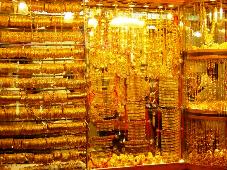 The threat of high gold imports -- 604 tonnes till September 2012 -- that is hurting the current account deficit has the government worried.
The threat of high gold imports -- 604 tonnes till September 2012 -- that is hurting the current account deficit has the government worried.
So, besides increasing the import duty to six per cent on Monday -- five times more than the one per cent that importers were paying last January -- it has allowed gold exchange-traded funds to put part of their gold holdings with banks for a nominal rate of interest.
The latter is good news for investors, as they could earn higher returns of 50-100 basis points by investing in gold ETFs. Gold ETFs have returned 10.18 per cent in the last one year.
In fact, if the fund houses choose, they can give higher returns of around 100 bps or a little more.
How? At present, banks like the State Bank of India pay 0.75 per cent annually (this figure could differ, depending on the bank) to customers who put gold in their gold deposit schemes.
In addition, fund houses incur a cost of 10 to 40 basis points when they keep gold with custodians.
Fund houses pay this from the annual expense ratio that they charge investors.
Most gold ETFs charge an expense ratio (percentage of the assets spent to run a fund) of 0.50 to nearly two per cent annually.
For example, Birla Sun Life Gold ETF charges 100 basis points as expense ratio.
So, when this proposal comes into effect, fund houses stand to save the money paid to custodians plus earn a fee for keeping the gold with banks.
Both combined, they stand to save and earn a good 100-125 bps.
Since
this amount will be earned by the scheme it will need to be passed on to the customers, thereby improving their returns.
Hemant Rustagi, chief executive officer of Wiseinvest Advisors says gold investors will benefit if ETFs earn from parking physical gold with banks because the extra revenue will go to the scheme and will get distributed to the investors.
Of course, the actual returns might be limited to 50-100 bps because ETFs will put only a part of the gold holdings with banks.
If the scheme really works well, then the gold which is basically lying with the ETFs can be monetised both for the scheme and its investors.
The Securities and Exchange Board of India is yet to unveil the fine print on how much gold ETFs can park with banks.
Even the Reserve Bank of India is yet to announce the returns ETFs can earn on gold kept with banks.
Despite the higher earnings, some like Dhirendra Kumar of Value Research are not very gung ho about it.
He feels there will be some apprehensions on the part of the mutual funds to park their gold with banks due to operational issues.
If too many investors want to redeem their investments and fund houses cannot realise their gold holdings from banks immediately, they will be in trouble.
It could take two-three days to realise the gold holdings because the gold stored with banks will be circulated.
“Hence, there can be initial apprehension to park capital for nominal returns,” he says. But if it works, gold would become a good investment option, instead of accumulation, much like the way it was recommended by the RBI’s working committee.

 The threat of high gold imports -- 604 tonnes till September 2012 -- that is hurting the current account deficit has the government worried.
The threat of high gold imports -- 604 tonnes till September 2012 -- that is hurting the current account deficit has the government worried.